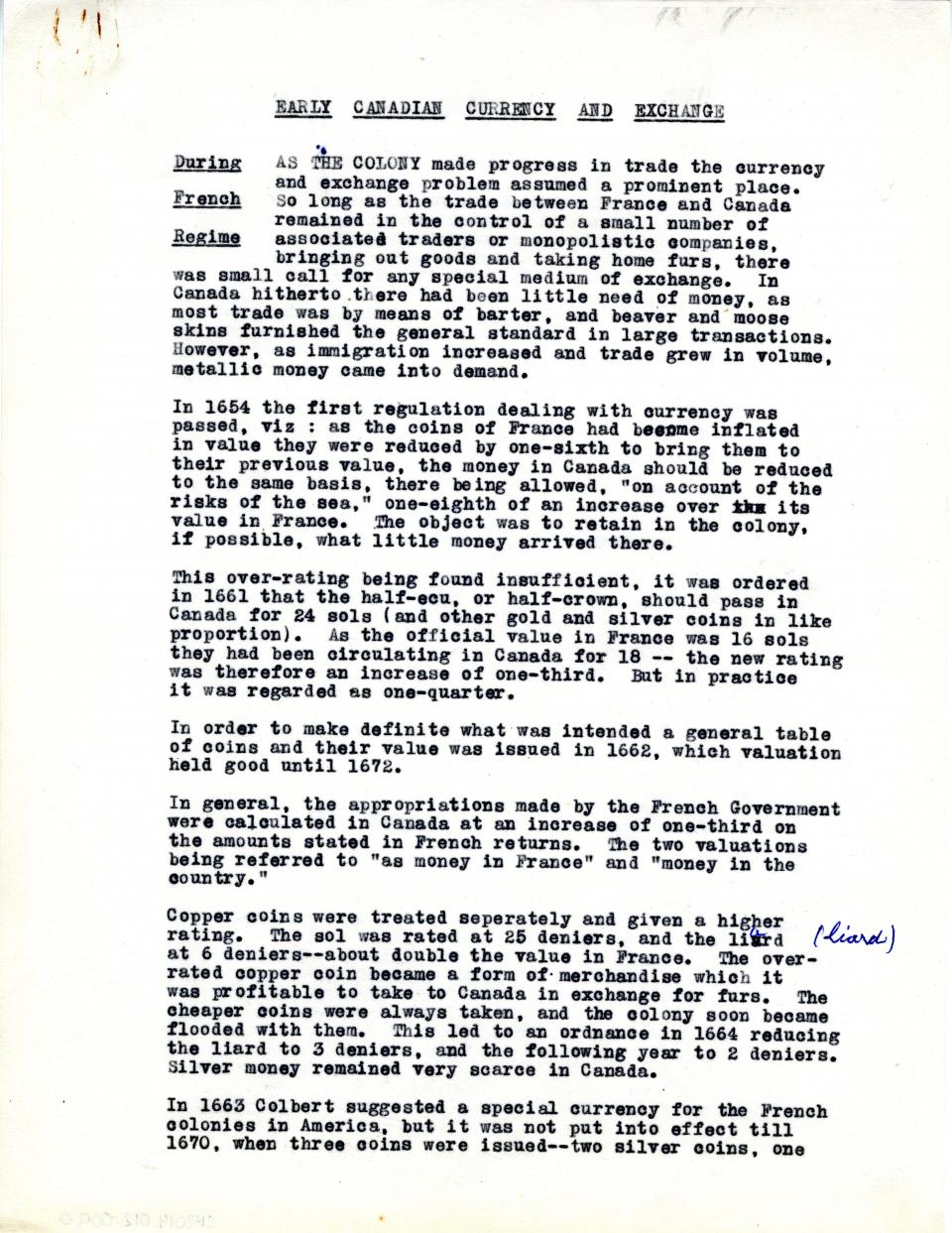
Length: 27.9 cm x Width: 21.5 cm
This is a typed essay titled "EARLY CANADIAN CURRENCY AND EXCHANGE". It is 13 pages long. Each page is typed and single sided.
a- This is the first page of the essay. It is under the heading of "During / French / Regime". It covers the adoption of metallic money over a barter system in 1654, and the use of French coins in Canada until 1670, when a new coin was issued. There is a margin note in pen that says, “liard”.
b- This is the second page of the essay. It speaks to the spread of money in French colonies, as well as the effect of the illegal fur trade. It ends by referring to the resulting Spanish Silver, that the English traded in when buying black market fur, and the ordinances on the valuation of money that then passed. There are some edits made in pen.
c- This is the third page of the essay. It speaks to the illicit fur trade being the reason for Frontenac's recall, the interest in Acadia, and an experiment in card money.
d- This is the fourth page of the essay. It speaks to the growing inflation in the colonies between 1690 and 1713, partially as a result of card money, and France's own financial conditions. There are some edits made in pen.
e- This is the fifth page of the essay. It speaks to the end of the card money experiment by 1721, and an experiment with a colonial currency. It also talks about a shipwreck that lost some 2,000 cards and so ordinary playing cards were stamped and used instead. It also speaks to the issuing of notes.
f- This is the sixth page of the essay. It speaks to the hoarding of French notes, which were then sold to the English in 1759. There is a small table at the bottom of the page that goes over the value of French coins.
g- This is the seventh page of the essay. It is under the heading "Under / British / Rule / 1760-1867". It speaks to the lack of standard, various types of coinage used, the cutting of coins, and the eventual ordnance in 1777 that created a standard. There are a few edits done in pen.
h- This is the eighth page of the essay. It speaks to the localization of currencies, such as the use of the York Shilling in Montreal, and the livre in Lower Canada. It also mentions the use of Jay's Treaty in 1794 which increased trade relations with the United States. There are pen edits made.
i- This is the ninth page of the essay. It speaks to the 1816 adoption of a uniform British currency, which Canada didn't adopt because, since trade with the United States was so strong, was used to using dollars and cents. The most common coin in use was the Spanish pistareen. There are some pound signs added in pen on this page.
j- This is the tenth page of the essay. It speaks to the different attempts and discussions to get a standard currency between 1825 and 1835. There is an edit made in pen on this page.
k- This is the eleventh page of the essay. It speaks to the adoption of a standard table of values of accepted coins, as well as fake copper coins that circulated, and the reduction of some Spanish and Mexican coins. There is a pen addition to this page.
l- This is the twelfth page of the essay. It speaks to the tension between adopting the American monetary system and the British one. The British government didn't want Canada to use an American system, and Canada wanted to stick with a dollar and cents system. This was arranged finally in 1858. The pound signs are added in pen.
m- This is the thirteenth page of the essay. It speaks to the adoption of since confederation, to the first distinctly Canadian coins in May of 1912. This page is marked at the bottom with "E.E. Horsey, / Kingston, / December, 1951." Over top of this is a signature in blue pen.
